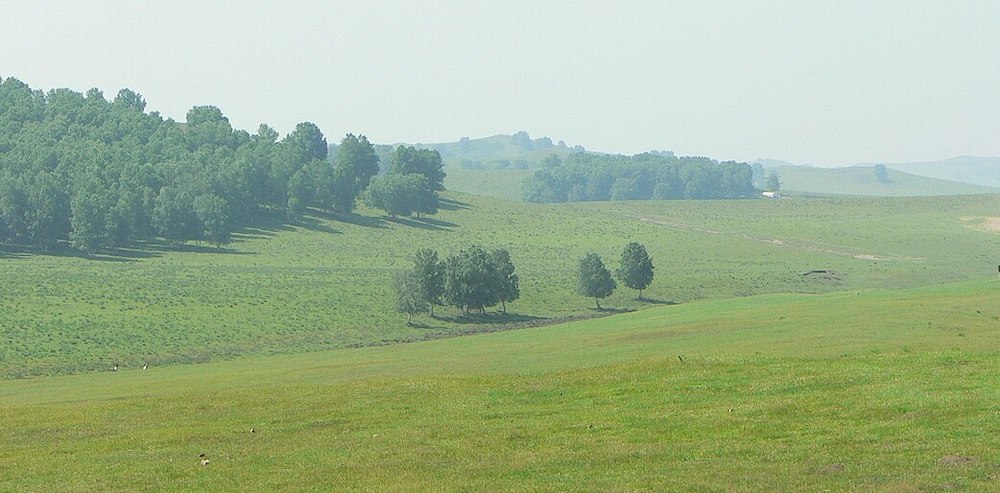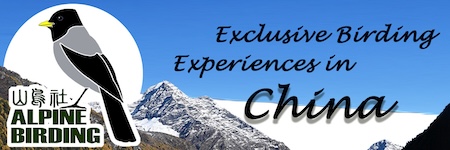Inner Mongolia Autonomous Region

Inner Mongolia is an autonomous region of the People’s Republic of China, located in the country’s north. From east to west, the region borders the provinces of Heilongjiang, Jilin, Liaoning, Hebei, Shanxi, Shaanxi, Ningxia Hui Autonomous Region, and Gansu, while to the north it borders Mongolia and Russia. It is the third-largest subdivision of China spanning about 1,200,000 km² (463,000 square miles) or 12% of China’s land area. It has a population of about 25 million. The capital is Hohhot with about 2.5 million inhabitants.
The majority of the population in the region are Han Chinese, with a substantial Mongol minority of around four million people, more than in Mongolia itself!. The official languages are Standard Mandarin and Mongolian, the latter written in the classical alphabet.
In the extreme southwest is the edge of the Tibetan Plateau where the autonomous region’s highest peak, Main Peak in the Helan Mountains reaches 11,670 ft. Most of Inner Mongolia is a plateau averaging around 1,200 metres (3,940 ft) in altitude and covered by extensive loess and sand deposits. The northern part consists of the Mesozoic era Khingan Mountains, and is owing to the cooler climate more forested, chiefly with Manchurian elm, ash, birch, Mongolian oak and a number of pine and spruce species. Where discontinuous permafrost is present north of Hailar District, forests are almost exclusively coniferous. In the south, the natural vegetation is grassland in the east and very sparse in the arid west, and grazing is the dominant economic activity. Overgrazing has led to desertification exacerbated by wind and dust storms.
Owing to the ancient, weathered rocks lying under its deep sedimentary cover, Inner Mongolia is a major mining district, possessing large reserves of coal, iron ore and rare-earth minerals, which have made it a major industrial region today. More than a quarter of the world’s coal reserves are located in the province.
_-_panoramio.jpg)
Winter in Ulanbutan Grassland – ©leej1118bj, CC BY 3.0 via Wikimedia Commons
The region is also a source of crude oil, with sites such as the Xifeng oil field producing tens of thousands of barrels per day.
Due to its elongated shape, Inner Mongolia has a four-season monsoon climate with regional variations. The winters in Inner Mongolia are very long, cold, and dry with frequent blizzards, though snowfall is so light that Inner Mongolia has no modern glaciers even on the highest Helan peaks. The spring is short, mild and arid, with large, dangerous sandstorms, whilst the summer is very warm to hot and relatively humid except in the west where it remains dry. Autumn is brief and sees a steady cooling, with temperatures below 0 °C reached in October in the north and November in the south.
Officially, most of Inner Mongolia is classified as either a cold arid or steppe regime. The small portion besides these are classified as humid continental in the northeast, or subarctic in the far north near Hulunbuir.
Birding Inner Mongolia
Inner Mongolia still harbours some global gems of wetlands and forest reserves, particularly Baiyinaobao Nature Reserve, Dalai Nur Nature Reserve, and in an adjacent district, Xilingol Biosphere Reserve. The region has wild ass, camel and Mongolian Gazelle and its reindeer are endemic to the region. There are also many rodents on the Inner Mongolia Prairie – about 54 species in all, or 35 percent of China’s total. Overgrazing and desertification means that the majority of the larger wild mammals are confined to reserves. Wildlife adversely affected by this desertification include the Mongolian Gazelle, Ussurian Moose, and Siberian Roe Deer; and among the birds, includes White-naped Crane, Great Bustard, Reed Parrotbill, and Relict Gull.

Summer Grasland – ©用心阁/Yongxinge, CC BY-SA 3.0 via Wikimedia Commons
Many other mammals and birds also closely associated with native grasslands and wetlands of the region and most are in decline.
The region has over 350 bird species amounting to about 30% percent of China’s total number of bird species. The regional bird is the lark.
-
Dalinuoer Lake Nature Reserve
InformationSatellite ViewLocated in Keshiketeng Banner of Chifeng (Ulanhad) City in Inner Mongolia Autonomous Region, the reserve covers a total area of 119,413 hectares. The nature reserve set up in 1987 and was upgraded into national nature reserve in 1997. Located on the important migration flyway in northern China, the reserve is an important stopover for migratory birds. The aim of the reserve is to protect rare birds and wetland resources. According to statistics, the reserve has recorded 190 bird species falling into 98 classes, 38 families and 16 orders. Among them there are 25 species of resident birds, 108 species of summer breeders, 55 species of travelling birds and 2 species of winter birds. Such as Demoiselle Crane, Eurasian Spoonbill, Swan Goose, Common Shelduck, Ruddy Shelduck, Common Pochard, Tufted Duck, Smew, Purple Heron, Black-tailed Godwit, Little Curlew, Relict Gull, Whiskered Tern, Daurian Jackdaw, Asian Short-toed Lark, Mongolian Lark, etc. -
Horqin Nature Reserve
InformationSatellite ViewLocated in the northern Xinjiamu Sumu of Hinggan League, the reserve was set up in 1985, upgraded to province-level nature reserve in 1994, and further upgraded to country-level reserve in 1995. Covering 126,987 hectares, the reserve aims at protecting rare bird species such as cranes and storks, and the echo system of the grasslands and wetlands upon which the birds live. The complex and varied habitats provide unique environment for the species to live and breed. The reserve has recorded 175 bird species including are 6 crane species. Such as Demoiselle Crane, Daurian Partridge, Eurasian Spoonbill, Black Bittern, Bar-headed Goose, Swan Goose, Falcated Duck, Common Goldeneye, Asian Dowitcher, Red-necked Stint, Caspian Tern, Little Tern, Golden Eagle, Northern Goshawk, Rough-legged Buzzard, Amur Falcon, Chinese Grey Shrike, Chinese Penduline Tit, Mongolian Lark, Greater Short-toed Lark, Asian Short-toed Lark, Meadow Bunting, Jankowski's Bunting, Chestnut-eared Bunting, etc. -
Saihanwula Nature Reserve
InformationSatellite ViewLocated in the northern Balin Right Banner of Chifeng (Ulanhad) City, the reserve was set up in 1997, upgraded into province-level nature reserve in 1998 and national nature reserve in 2000, and was included into World Biosphere Reserve in 2001. Covering 100,400 hectares, the reserve is located in the joint area of three animal faunas, namely Northeast, North China and Mongolian-Xinjiang. A preliminary survey shows this reserve has 151 bird species falling into 47 families under 17 orders. Such as Demoiselle Crane, Eurasian Spoonbill, Swan Goose, Taiga Bean Goose, Upland Buzzard, Amur Falcon, Little Gull, Gull-billed Tern, Azure-winged Magpie, Mongolian Lark, Chinese Hill Babbler, Godlewski's Bunting, Meadow Bunting, etc. -
Ulansuhai Nur Lake
InformationSatellite ViewLocated in the Wulate Front Banner of Bayannaoer League in Inner Mongolia, Ulansuhai Nur Lake is the largest lake in Yellow River valley covering the total area of 300 square kilometers and is one of the eight largest fresh water lakes. Because of its unique geographical location and favorable climatic conditions, the wetlands around the lake have become ideal breeding spot for resident and migratory birds and important migration stopover for the eight migratory passages in the world. According to the survey, this area has recorded 240 species of birds. Such as Eurasian Spoonbill, Mute Swan, Red-crested Pochard, Common Pochard, Ferruginous Duck, Black-winged Stilt, Pacific Golden Plover, Kentish Plover, Grey-headed Lapwing, Ruddy Turnstone, Curlew Sandpiper, Red-necked Stint, Green Sandpiper, Spotted Redshank, Little Tern, Gull-billed Tern, Amur Falcon, Isabelline Shrike, Chinese Grey Shrike, Crested Lark, Oriental Reed Warbler, Richard's Pipit, etc. -
Wuerqihan
InformationSatellite ViewLocated in the west of Da Hinggan Range (Greater Khingan Range), Wuerqihan is the closet forest from Yakeshi that occupied by lush coniferous forest where inhabited by a lot of northern specials including owls, pheasants, tits, etc. Such as Ural Owl, Northern Hawk-Owl, Great Grey Owl, Eurasian Eagle-Owl, Boreal Owl, Arctic Redpoll, Black-billed Capercaillie, Hazel Grouse, Black Grouse, Siberian Jay, Pallas's Rosefinch, Asian Rosy Finch, Arctic Redpoll, Common Redpoll, Hawfinch, Pine Grosbeak, Two-barred Crossbill, Eurasian Siskin, Long-tailed Tit, Willow Tit, etc.
-
Wikipedia
GNU Free Documentation License
https://en.wikipedia.org/wiki/Inner_Mongolia -
Alpine Birding
http://www.alpinebirding.com/Resource/bird-info/provincial/19.html
-
Number of bird species: 515
(As at June 2024)
-
Avibase
PDF ChecklistThis checklist includes all bird species found in Inner Mongolia , based on the best information available at this time. It is based on a wide variety of sources that I collated over many years. I am pleased to offer these checklists as a service to birdwatchers. If you find any error, please do not hesitate to report them.
-
NNR Dalai Lake Biosphere Reserve
InformationSatellite View…complex of lakes, rivers, marshes, shrubs, grasslands and reed beds typical of wetlands in arid steppes, still retaining near-natural conditions. A staging area in the East Asian-Australasian Shorebird Flyway, the site is important for some 284 bird species… -
NNR Eerduosi
InformationSatellite ViewA typical Euro-Asian grassland and Asian desert with high ecological fragility, including a large number of permanent freshwater and saline lakes and pools, with islands, and human-made aquaculture ponds. The sites supports some 15,000 breeding Relic gull Larus relictus -
NNR Xilinguole
InformationSatellite ViewWildlife in the Reserve reflects the feature of fauna of Mongolian Plateau including 33 mammal species such as Mongolian gazelle, wolf and fox, etc., and 76 species of bird including swans and larks and various insects as well… -
NR Ke'erqin
InformationSatellite ViewThere are 452 species of higher plants and 167 species of birds in the Reserve, among which 34 are protected animals…
-
Alpine Birding
Tour OperatorClassic birding tours for avid birders including yearly-run trips and new trips developed by the AlpineBirding team and guided by our experienced bird experts. -
Beijing Bikers
Tour OperatorBirding trip in the Alashan Desert, Inner Mongolia -
Bird-Photo-Tours ASIA
Tour OperatorBird-Photo-Tours ASIA is the specialists in bird photography tours on the Asian continent with a portfolio of 50 bird photography tours across 26 countries and a particular specialism in bird photography in China including Inner Mongolia Province.
-
2016 [11 November] - Max Berlijn
PDF ReportList and photos -
2017 [03 March] -
BLOG entry
-
Shanghai Birding
Webpage“Birding China’s Extreme Northeast” covers trips to northern Inner Mongolia and eastern Heilongjiang in the winter and summer of 2015. There are also brief entries from Hohhot in south-central Inner Mongolia.


